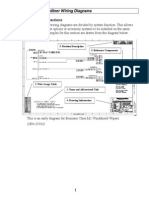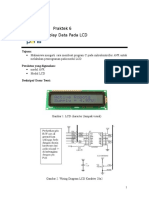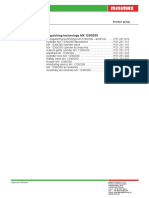Programming LCD Display (16x2) With PIC16F877A
Uploaded by
Hisyam SaniProgramming LCD Display (16x2) With PIC16F877A
Uploaded by
Hisyam SaniE:\PIC_aku\LCD_16\project_LCD\programming_LCD.
//Project: 16X2 Character LCD Lesson
//Programmer: hisyamsani bin idris
//PIC: PIC16F877A
//Crystal Frequency: 20MHz
//Compiler: HI-TECH ANSI C
//Last Modified: 1 Dis 2010
//Website: http://robot-geek.blogspot.com
#include <pic.h>
#include <htc.h>
__CONFIG(0x3F3A);
#define LCD_RS RD0
#define LCD_RW RD1
#define LCD_EN RD2
#define LCD_LIGHT RD3
#define LCD_DATA PORTD //D7-D4
#define LCD_PULSE() ((LCD_EN=1),(LCD_EN=0))
#define LCD_shift RB0
#define _XTAL_FREQ 20000000
void pic_init(void);
void lcd_init(void);
void lcd_write(unsigned char c);
void lcd_clear(void);
void lcd_goto(unsigned char pos);
void lcd_string(const char *s);
main()
{int a;
pic_init(); //initialize PIC
lcd_init(); //initialize LCD
lcd_goto(0x00); //select first line
lcd_string("robot-geek.blogspot"); //display string
lcd_goto(0x40); //select second line
lcd_string(" hisyamsani "); //display string
for(;;){
LCD_LIGHT=1;
for(a=1;a<=20;a++)
__delay_ms(20);
LCD_LIGHT=0;
for(a=1;a<=20;a++)
__delay_ms(20);
}}
void pic_init(void)
{
TRISA=0b00000000;
TRISB=0b00000000;
TRISC=0b00000000;
TRISD=0b00000000;
TRISE=0b00000000;
ADCON1=0b00000110;
PORTA=0b00000000;
PORTB=0b00000000;
PORTC=0b00000000;
PORTD=0b00000000;
PORTE=0b00000000;
}
/* initialise the LCD - put into 4 bit mode */
void lcd_init(void)
{
__delay_ms(15); //delay for LCD Power Up
lcd_write(0x28); //function set
lcd_write(0x0C); //display on/off control
lcd_clear(); //clear screen
lcd_write(0x06); //entry mode set
LCD_shift=1;
}
/* write a byte to the LCD in 4 bit mode */
1
E:\PIC_aku\LCD_16\project_LCD\programming_LCD.c
void lcd_write(unsigned char c)
{
LCD_DATA=(LCD_DATA&0x0F)|(c&0xF0);
LCD_PULSE();
LCD_DATA=(LCD_DATA&0x0F)|((c<<4)&0xF0);
LCD_PULSE();
__delay_us(40);
}
/* clear LCD and goto home */
void lcd_clear(void)
{
LCD_RS=0;
lcd_write(0x1);
__delay_ms(2);
}
/* write a string of chars to the LCD */
void lcd_string(const char *s)
{
LCD_RS=1; // write characters
while(*s)
lcd_write(*s++);
LCD_shift=1;
}
/* go to the specified position */
void lcd_goto(unsigned char pos)
{
LCD_shift=1;
LCD_RS=0;
lcd_write(0x80+pos);
}
You might also like
- Body Controller Diagnostic Trouble Codes International 3200, 4100, 4300, 4400, 7300, 7400, 7500, 7600, 7700, 8500, 8600 Fault Code List PDF100% (7)Body Controller Diagnostic Trouble Codes International 3200, 4100, 4300, 4400, 7300, 7400, 7500, 7600, 7700, 8500, 8600 Fault Code List PDF30 pages
- 1984 GMC Light Duty Trucks Service Manual95% (19)1984 GMC Light Duty Trucks Service Manual1,746 pages
- Detroit GHG17 Heavy Duty Troubleshooting Manual PDF100% (22)Detroit GHG17 Heavy Duty Troubleshooting Manual PDF3,104 pages
- Trailer Life RV Repair and Maintenance Manual (PDFDrive)100% (3)Trailer Life RV Repair and Maintenance Manual (PDFDrive)496 pages
- Wiring Diagrams+Service Manuals+EWD+E-books+Software10% (21)Wiring Diagrams+Service Manuals+EWD+E-books+Software91 pages
- Bendix EC-80 ABS / ATC Controllers: (ABS) Devices Designed To Help Improve The Braking100% (3)Bendix EC-80 ABS / ATC Controllers: (ABS) Devices Designed To Help Improve The Braking44 pages
- Kitchen Aid k45 Service Manual For Hobart Made Vintage Mixers Compress100% (1)Kitchen Aid k45 Service Manual For Hobart Made Vintage Mixers Compress30 pages
- The Colonization of Tiamat V (Phoenix III, Daniel) PDFNo ratings yetThe Colonization of Tiamat V (Phoenix III, Daniel) PDF44 pages
- (Hack) Cellular-Manual - Cell Phone Phreaking83% (18)(Hack) Cellular-Manual - Cell Phone Phreaking24 pages
- TI-Nspire Programming - TI-Basic DeveloperNo ratings yetTI-Nspire Programming - TI-Basic Developer14 pages
- #Include #Define #Include Int Void: " Microp&Interf"100% (2)#Include #Define #Include Int Void: " Microp&Interf"2 pages
- Librerias LCD para Manejo en Avr Archivo en C100% (1)Librerias LCD para Manejo en Avr Archivo en C11 pages
- Implementation of White Line Following Firebird V RobotNo ratings yetImplementation of White Line Following Firebird V Robot11 pages
- code vi xử lý cho cảm biến nhiệt độ LM 35 hiển thị trên đèn led và màn hình LCDNo ratings yetcode vi xử lý cho cảm biến nhiệt độ LM 35 hiển thị trên đèn led và màn hình LCD4 pages
- Soalan PRA MySkills 2013 - Release PublisNo ratings yetSoalan PRA MySkills 2013 - Release Publis11 pages
- Major Project Report: K.L. Polytechnic, RoorkeeNo ratings yetMajor Project Report: K.L. Polytechnic, Roorkee1 page
- ATMega16 Microcontroller Digital LM35 LCD Thermometer100% (3)ATMega16 Microcontroller Digital LM35 LCD Thermometer4 pages
- Raport: Universitatea Tehnica A MoldoveiNo ratings yetRaport: Universitatea Tehnica A Moldovei11 pages
- PIC C, Serial LCD Routines, CCS PCW CompilerNo ratings yetPIC C, Serial LCD Routines, CCS PCW Compiler4 pages
- Security Management in Wireless Sensor Network (WSN)No ratings yetSecurity Management in Wireless Sensor Network (WSN)4 pages
- NF EN 14566+A1 - Mechanical fasteners for gypsum plasterboard systemsNo ratings yetNF EN 14566+A1 - Mechanical fasteners for gypsum plasterboard systems34 pages
- Comparison of Conventional and Bio-Treated Methods As Dust SuppressantsNo ratings yetComparison of Conventional and Bio-Treated Methods As Dust Suppressants10 pages
- Lecture 4 Introduction To Analog and Digital Communications, S. Haykin, M. Moher, 2ndNo ratings yetLecture 4 Introduction To Analog and Digital Communications, S. Haykin, M. Moher, 2nd10 pages
- 77 TOP Electric Traction - Electrical Engineering Multiple Choice Questions and Answers - MCQs Preparation For Engineering Competitive Exams50% (2)77 TOP Electric Traction - Electrical Engineering Multiple Choice Questions and Answers - MCQs Preparation For Engineering Competitive Exams8 pages
- Management of The Soft Palate Defect Steven Eckert PDFNo ratings yetManagement of The Soft Palate Defect Steven Eckert PDF15 pages
- Course Outline: Addis Ababa University Department of Computer ScienceNo ratings yetCourse Outline: Addis Ababa University Department of Computer Science1 page
- Notes On Philosophy and The Scientific Image of ManNo ratings yetNotes On Philosophy and The Scientific Image of Man6 pages
- Mathematical Model For LCL Filter With AFE ConverterNo ratings yetMathematical Model For LCL Filter With AFE Converter4 pages
- Three-And Four-Point Method: Resistance MeasurementsNo ratings yetThree-And Four-Point Method: Resistance Measurements8 pages
- Process Description For PLC Program DesignNo ratings yetProcess Description For PLC Program Design4 pages























































































































